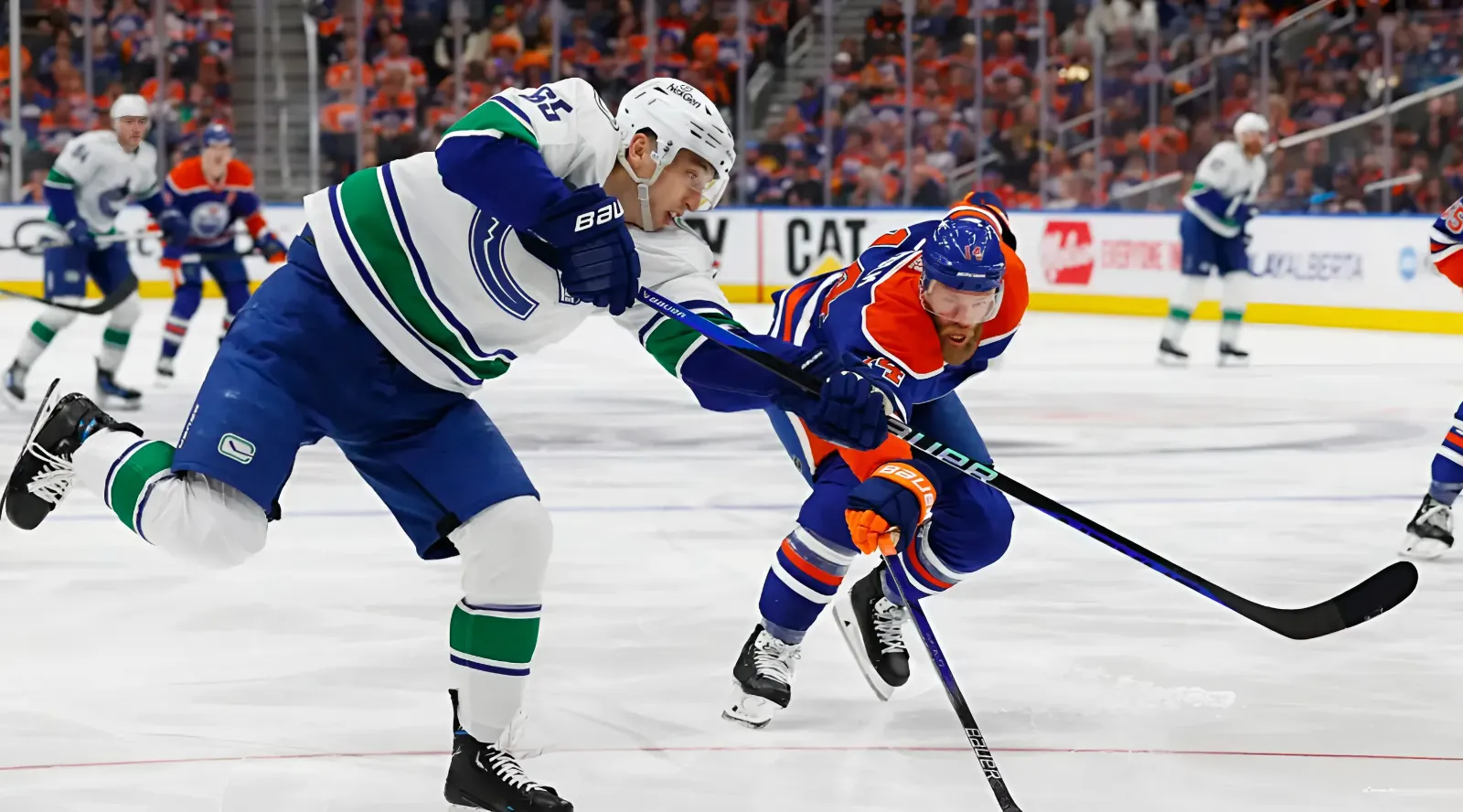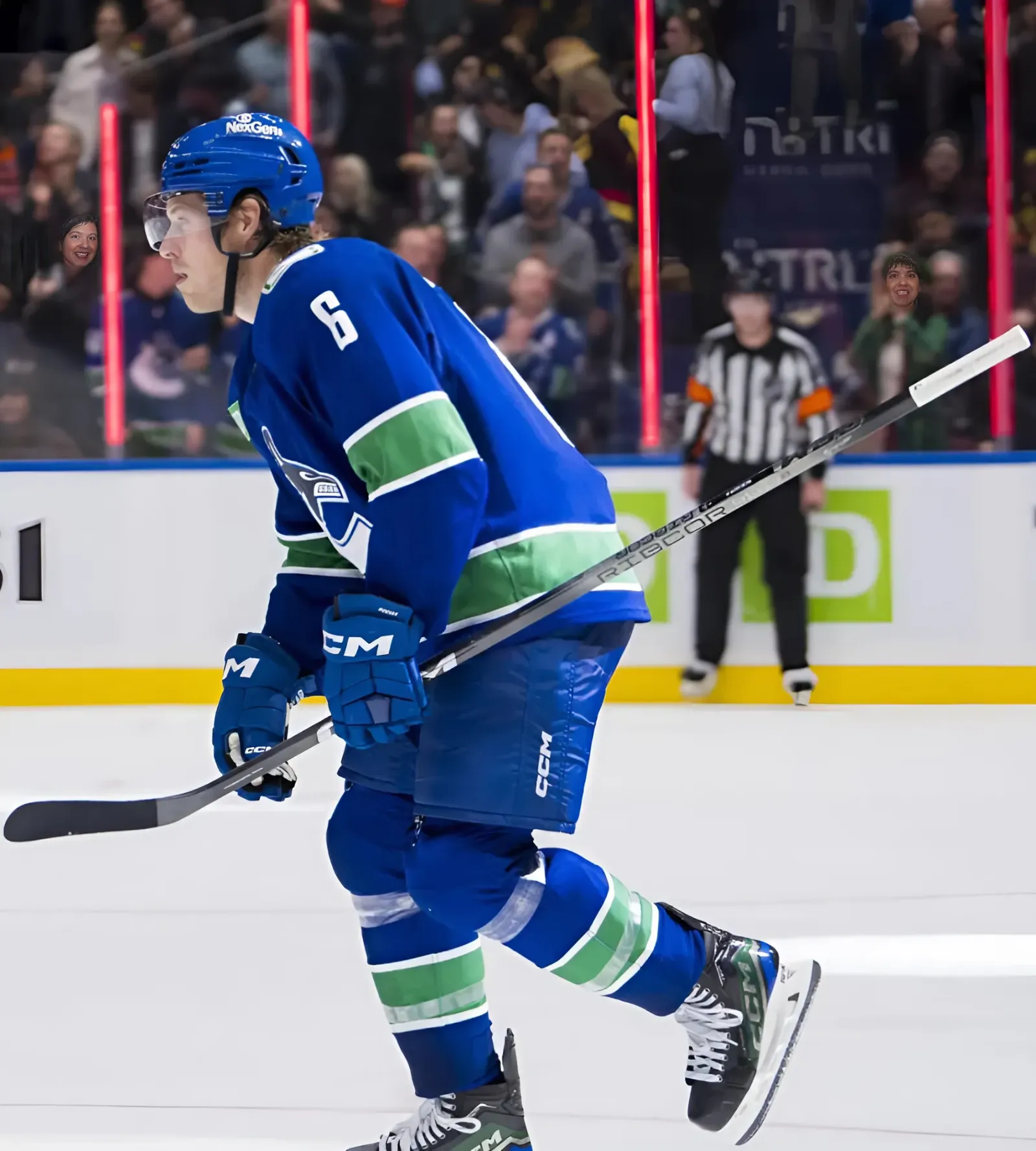When Michael Brandsegg-Nygård crosses the NHL draft stage Friday night, he’ll be carrying thousands of NHL dreams with him.
They’re his father’s dreams, the ones sold painfully short by a lockout. They’re his peers’ dreams, the ones held by hundreds of players in the small Norwegian hockey community who will see their highest drafted countryman ever. And they’re his own dreams, the ones he’s held since he was a little boy of playing professional hockey.

As much as Friday is about Brandsegg-Nygård’s hockey journey, it’s just as much a story about the Norwegian hockey community, and what he and his country dream will prove the beginning of a new trend. As he and longtime friend Stian Solberg become the country’s first ever first round draft picks, they represent Norwegian hockey’s growth in the past 18 years.
“Norwegian hockey is getting better and better every year. And now, because maybe me and Solberg are hopefully getting drafted in the first round, we think maybe young kids in Norway see that you can be a good hockey player in Norway, too,” Brandsegg-Nygård told the Hockey News, recalling his hockey journey over the phone Tuesday before he traveled to Vegas for the draft. “And it gives them a lot of motivation and energy to keep going and so everyone can see Norway can be a good hockey nation, too.”
Role models like Brandsegg-Nygård can take Norway even higher.
When Brandsegg-Nygård was growing up, he always wanted to be like his dad. Not just because his dad was a professional hockey player, and not just because most kids look up to their parents like superheroes.
“When I was younger, I always looked up to my dad because I felt like everyone at the rink knew him,” Brandsegg-Nygård said. “And he has also been a big supporter of me. He has a good balance when he's helping me, he’s not like a crazy dad that all he wanted me to do (was) practice all the time. He is one of the reasons that I have come so far as I have already came, but it's also a long way to go now.”
Richard Nygård was a well-respected player in Norway during his 14-year pro career, one of its stars not through rote skill but through his consistency and work ethic. It was these traits that nearly earned him a contract in North America.
Back in the summer of the 2004-05 season, the San Antonio Rampage watched Richard’s film and liked what they saw. Richard earned a tryout invite, and with it a chance to make it to the AHL — just an arm’s reach from his NHL dreams.
Then, the NHL lockout happened, filling the AHL with NHL talent and ending Richard’s journey before it started. And when Michael was born in October 2005, Richard had to make a sacrifice. With a family started in Norway, he couldn’t just globetrot chasing NHL dreams. So, he stayed put in Norway and kept playing for Valerenga Ishockey. Instead of moving on to a bigger and better league, he became a builder.
Michael watched every game, every shift and every shot. Even as a toddler, Michael’s eyes darted around the rink watching the game in a way that made his dad chuckle.
What Michael exudes as a hockey player — the hard work, the effort, the shot — he got a lot of it from his dad. Everything but the skating. That came from his mom, an accomplished junior soccer player in Norway who first got Michael on the ice.
“Actually it was his mom who was most on the ice when he was two, because I lost my patience,” Richard told The Hockey News. “… He was just sitting on his bum and didn't want to, so I was just kind of giving up. She took over and had the patience. When he figured it out, that's all he wanted to do.”
He always wanted a stick in his hands, too. When Richard’s sister got Michael a mini stick for Christmas one year, he spent countless hours playing hockey inside. He and his grandma would play mini sticks when Michael visited her, and his uncles would play with him too. It kept Michael busy, as well as the adults who had to fix the marks he left on the walls.
By the time mini sticks grew to real ones, Michael benefited from a big development in Norwegian youth sports. With the help of training from USA Hockey representatives, Norway installed a Learn to Play development model in 2003 that prioritized player development beyond wins and losses. Players had to have the same amount of ice time until they were 14. Practice structures focused on skill development through small area games and competition rather than just scrimmages and bag skates. And the coaches running those practices? Highly trained compared to their predecessors. Richard was one of those coaches, and he remains involved in Norwegian youth hockey long after his son has moved on to other leagues.

Michael Brandsegg-Nygård takes a shot against Great Britain in a game at the IIHF Men's World Championship May 20, 2024.
Part of the reason coaches are so committed in Norway is because the sport depends on it. Hockey is small potatoes compared to skiing and soccer, and that size dampens the overall ability of Norwegian teams. The Norwegian men’s and women’s programs rank 12th and 14th in the IIHF rankings. With only a few thousand enrolled players, losing one youth player is a blow to the entire operation. Even after Learn to Play programs give way to competitive leagues, Norwegian junior teams constantly pool knowledge and resources to put their players in the best positions to succeed.
“That's been a big, big thing that we've changed for the last couple of years that we're doing and we're working together,” Norway U20 coach Christer Nylund told The Hockey News. “We understand the situation where we are. I don't think we'll ever be able to compete with the big teams and that's not our goal, like competing with the US and Canada and Sweden and so on. It’s about the players and how many players you have in your program.”
So how does Norway overcome this?
“We've chosen to try to play in a style that develops the players, but we understand that that might also give us less results,” Nylund continued. “Our feeling is that we want players to play with speed and to pressure the puck carrier and be able to do things with the puck, and then we understand that sometimes it might backfire on us. And we might lose some games that might be real critical. But that's just how it is. I think we can develop better players with that kind of mindset.”
They can develop Michaels, so to speak, who outwork opponents and peers who might have more raw talent but lack the sort of work ethic to put it all together.
In Michael’s generation, a number of really good players have come about, headlined right now by him and Solberg. And it’s been like that for a long time. Whereas the fundamentals were always there, they really took off once Michael gained some size. By 14, he started beating his dad when they played outside. Michael got strong, and he wasn’t shy about wielding his power.
“I always said to him when you guys turn 18, we're gonna go in the boxing ring and we're gonna have a match with the gloves,” Richard said. “But I’m reconsidering. I don’t know if I want to do that.”
The same goes when Michael takes the ice. He’s got a quick shot and refined forechecking technique, but what stands out about him is his competitive nature.
“He never lets someone take the puck or win easy. He don’t want to take shit, if you know what I mean,” Mora IK coach Daniel Hermansson told The Hockey News. “If he gets hit, he wanna hit that guy back really hard. That type of mindset, and I love it.”
Added Nylund, “When he gets that helmet on, something happens with him. The players I’ve worked with throughout my career, I think that's maybe the most important thing that you can have as a player, like getting that helmet on and then just being so focused and so competitive in the game.”
Michael showed that takeover trait throughout his career in Norwegian juniors. As a 16-year-old, he scored 24 goals and 42 points, ranking third and sixth in the league. He was an unstoppable force that turned his team into an immovable object.
And he only got better in the postseason. Even with all eyes paying attention to him, even with game plans schemed around him, Michael found a way to finish with six points in eight games, tied for fourth in the playoffs. And in the championship game against the Stavanger Oilers — coached by his national team coach, Nylund — his competitive drive took over. When the championship went to overtime, Michael went into overdrive.
“Of course, Michael was the guy scoring the goal for the opponent,” Nylund chuckled. “I just knew that OK, now he’s on the ice, I need to have my best guys on the ice and it might not help — and it didn't. That was so Michael, you know. He wanted to be the guy who won the game.”
Michael loved that his time playing in Norway ended with such an exclamation point.
“I mean, that was just a dream,” Michael said. “Valerenga is the team I'm most proud of to play with and it's a team that I have grown up with, the team that my dad played with his whole life, too. And it's a team that I care a lot about. It was so cool to be the guy that scored the last goal so we could win the Norwegian Championship. That was just a dream.”
But soon, bigger dreams meant that Valerenga and the small ecosystem of Norwegian hockey didn’t fit. Michael needed a big role to develop through ice time, but he wasn’t good enough yet to take a spot on the men’s teams. Even his dad, a huge proponent of Norwegian hockey, recognized it. And when none of the teams in Norway’s men’s league could offer him a roster spot where he could get a regular shift, Michael had to go elsewhere.
“Especially in Norway, I feel like you have to move at some point to be a hockey player and to reach a dream,”: Michael said. “I felt like I was ready, and it was the right moment for me to move.”

Norway forward Michael Brandsegg-Nygård celebrates a goal with teammate Noah Steen in the IIHF World Junior Championship on January 4, 2024.
As Hermansson remembers it, scouting Norway with his Mora IK club came more from necessity than brilliance. It worked all the same.
In Sweden, junior players pick which teams they will sign with, and Mora isn’t at the top of the list. A lot of the top players in the country chose other teams such as Frolunda, Rogle and other teams in the first-tier Swedish Hockey League. For a club like Mora IK in the second-tier HockeyAllsvenskan, not as many players want to sign there. And the players who chose Mora weren’t the kind of stars that the staff felt confident would translate to the pro level.
“We needed to go outside of Sweden,” Hermansson said.
They needed to go to Norway and Switzerland, two proven wells for his team to tap talent. And after watching Michael’s film, he was one of Mora’s targets. So were fellow Norwegians Petter Vesterheim and Patrik Dalen.
Hermansson’s pitch was simple: Swedish hockey is a lot stronger than Norway, and Michael could grow more against top competition. And on a team that needed to infuse talent, he could give him a top six spot with power play privileges. It was exactly the opportunity Michael was looking for, even if it required him to uproot his life at the ripe age of 16.
At any age, moving to the SHL was a risk for Michael. Across the history of the league, Norwegian players haven’t always thrived in the Swedish leagues. Many cautionary tales swirled around Norway’s hockey circles.
“If you look back four, five, 10 years ago, players always talked about how you can go to Sweden but you will be back in two or three years,” Nylund explained. “Or if you go to Sweden, and there's a player that’s Swedish and is on the same level, they will always choose the Swedish guy. So there were a lot of these kinds of talks back in the day.”
Michael wasn’t the first player to grapple with this reality. Perhaps the most successful Norwegian hockey player at the NHL level, Minnesota Wild star Mats Zuccarello, made the jump back in 2008-09. But he was 21 and had played two seasons against men in Norway. Michael making the transition was far earlier than most of his peers. Even Solberg, his teammate and fellow top prospect, wasn’t thinking about leaving Norway quite yet. And his dad, a Norway hockey lifer, was conflicted.
“I'm not the guy who (thinks it’s) necessary to go over to a better league in Sweden,” Richard said. “I feel like Norway is a pretty good place to develop when you're young at the junior level.”
The caveat is that the league has to offer players a proper role. Look at Solberg, who played top minutes for Valerenga’s men’s team in 2023-24. This environment allowed him to improve his play through high reps while also showing scouts the type of role he could play. Even if Norway is a non-traditional league, players can generate some scouting buzz in big time roles.
In the end, it came down to role. Sweden gave Michael a shot in the top six against better competition. Norway would have sheltered him in a smaller role. So, Michael made the move.
And if anyone doubted Michael could hack it in Sweden, he settled those doubts just about as soon as he landed. In a J20 game against Skelleftea, he showed that his elite shot and work ethic could make him a star.
“It was the beginning of the season, so I didn’t really know how Michael should do in the league,” Hermansson reminisced. “We hope of course that he should be good, but we didn't really know. Skelleftea were the better team but he scored three goals. Those kind of quick release, great move kind of goals. That was the early memory from him, like oh my god that kid can play and he can shoot the puck.”
With such a hot start, Michael wasn’t just a big contributor for Mora. He was a player its coaches wrote game plans around. Forget about perceived Swedish bias — Michael was too talented to ignore, especially on the box score. His 38 points in 35 games ranked second on his team behind Mora teammate and fellow Norwegian Vesterheim, but fifth in the league among all U17 skaters.
Scoring was just half the story. How he did it was more impressive.
“I have never seen a guy who likes to compete more in the practices,” Hermansson recalled. “When we’re competing, when we have a scrimmage or when we have a small game in a practice — he's competing, competing, competing. … He’s one of those guys as a coach you need to go out like, ‘Michael, you need to come in now, you can’t practice more. The bus leaves or you need to go eat.’”
With Michael and Vesterheim leading the way, Mora won its division in the regular season but didn’t go deep into the J20 playoffs. Then, Michael went up to the senior league for his draft year. In his first full season against grown men, Michael put up 18 points in 41 games. And even against professionals, his competitive spirit impressed his peers and coaches.
And in the process, he also changed some people’s thoughts about making the jump to Sweden. Maybe Norwegians could make it big in Sweden.
“It's a fun thing and everybody's proud about his success,” Nylund said. “And I think that we are getting better at finding that proudness in the player’s success. It’s maybe not been like that before.”
To Norway, Michael is a role model for players who come after him. Take a look at top 2025 prospect Mikkel Eriksen, who split last season between Norway and Sweden. And even if he stayed put in Norway last season, Solberg is following Michael over to the SHL next season.
For Norway’s hockey programs, it’s a balancing act to produce great players while also benefiting the growth of hockey in the country. But with players like Michael thriving internationally, sometimes letting the birds leave the proverbial nest benefits everyone. And just like this year’s draft process, it just took Michael to show that it could be done.
***
Back in 2016, Zuccarello described his journey from Norway in an article for the Players’ Tribune. And nearly every word bears significance to Michael’s journey eight years later.
“People always ask me to describe Norway to them,” Zuccarello wrote. “I always say the same thing: misunderstood. You might not be able to find us on a map. You’ve probably confused us with Sweden once or twice before. And no, that’s probably Iceland’s flag and not ours that you’re picturing right now. So if you’re ever stumbling around Scandinavia and make your way to Norway, come visit. We’ll pretend that you’ve known about us all along.”
Whereas Norwegian hockey circles knew just how good Michael and Solberg were, the rest of the world really figured it out as the season wore on. In the span of a year, both went from barely known prospects to first round projections. And at the IIHF Men’s World Championships — alongside Zuccarello himself — they had their full coming out party. As an 18-year-old against the best talent in the world, Michael finished with five points in seven games, only trailing Zuccarello and Norwegian hockey legend Patrick Thoresen, once a national team teammate of Michael’s father. Solberg, meanwhile, impressed scouts with his ability to shoulder top pairing minutes for an often overmatched Norwegian team.
The spotlight of the moment wasn’t too big for either prospect.
Weeks after the tournament, a conversation with a development coach made it all click for Michael. As Michael recalled his coach saying, “Me and Solberg aren’t afraid of anything. We always played with older guys, and every practice we came to, we didn’t think about if we take the puck from this guy or try to hit him hard, if he doesn't really like us or something. Me and Solberg didn’t care about that.”
They’ve only cared about being the best players they can be against anyone they’ve played against. That’s what it takes to be trailblazers, and that’s why they’re poised to be the nations’ first ever first round picks at Friday’s NHL Draft.
Those IIHF tournaments are still tricky for Norway. The U20 team made it to the top division of the World Junior Championship in 2024, only to get relegated immediately. In the Men’s World Championship, Norway finished with a 2-0-0-5 record, good for sixth out of eight teams in Group A. It was just enough to make it back to next year’s championship.
Players like Michael and Solberg can infuse a lot more talent to the lineup as they continue to develop. From a country that has produced just nine NHL players ever — whose highest ever draft pick, Marius Holtet, went 42nd overall all the way back in 2002 — the two Norwegian phenoms are a revolution in their overall skill level.
There’s a sense of humility that Michael exudes when he talks about the history he could make. On the one hand, he knows that he’s got a great shot to achieve in the NHL, becoming a role model for those who come after him. On the other, he knows how hard the road ahead will be. As much as he has accomplished — for his nation and for himself — Michael has more to go. And he’s planning for it. Even in the week leading up to the draft, he spent it training to be in shape for development camp.
Even going through the draft process hasn’t fazed Michael or Solberg. They’ve mostly gone into the process raw, impressing scouts and media at the NHL combine for their maturity. Michael himself has fielded questionnaires from all 32 NHL teams during his draft year, writing answers to the kind of philosophical questions that would make Herb Brooks blush.
Seeing his son living these dreams gives Richard immense pride. It wasn’t too long ago that he was the one trying to get so much as a sniff at the NHL, and now his son is poised to make history.
“I know how difficult it is,” Richard said. “It’s like threading a needle and finding a needle in a haystack. Not until this point now did I know, ‘OK he's gonna get picked in the first round.’ If you had said that to me like one and a half years ago, I would say ‘Really? I don't think so,’ partly because of how small Norway is.”
But even small ponds produce big fish. In the end, Michael, alongside Solberg, is a trailblazer representing what has made Norway more competitive in hockey. As he continues to forge new paths, Michael inspires Norwegian peers to play at higher leagues, and he inspires higher leagues to invest in Norwegians that they might otherwise overlook.
“I think when you have Michael and these kinds of players who, in a way, open the door, it becomes a trend among Norwegian players to take the step and maybe be the next guy who makes that journey,” Nylund said. “... I don't think Michael has thought so much about that, being the guy who's opening the door, but of course he's a big name in Norwegian hockey and they like to watch him play and watch the road that he’s done.”
Where that road leads next is anyone’s guess. Michael is expected to be picked midway through the first round, with a number of teams interested in his blend of forechecking and shooting. Many mock drafts have him joining the Detroit Red Wings, while others have him going as high as 11th to the Buffalo Sabres or as low as 18th to the Chicago Blackhawks.
Whichever team gets Michael Brandsegg-Nygård, he’ll be opening yet another door. And it will be wide open for the next Norwegian will be to follow him.

Michael Brandsegg-Nygård looks at the Norwegian flag with his teammates as the Norwegian national anthem plays following a win against Great Britain in the IIHF Men's World Championship on May 20, 2024.



